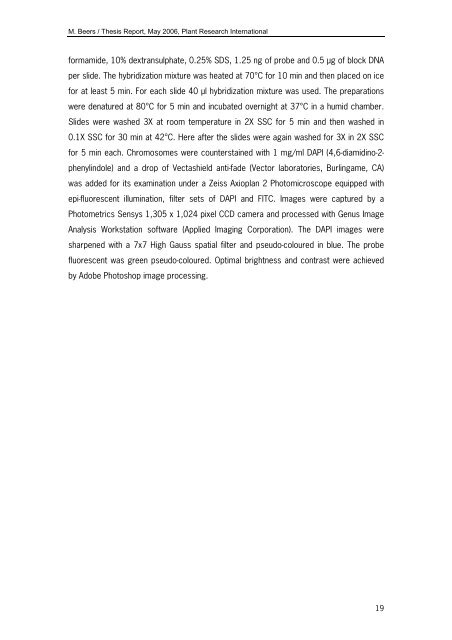Thesis report PRI_Martin Beers_final - The Lilium information page
Thesis report PRI_Martin Beers_final - The Lilium information page
Thesis report PRI_Martin Beers_final - The Lilium information page
You also want an ePaper? Increase the reach of your titles
YUMPU automatically turns print PDFs into web optimized ePapers that Google loves.
M. <strong>Beers</strong> / <strong><strong>The</strong>sis</strong> Report, May 2006, Plant Research International<br />
formamide, 10% dextransulphate, 0.25% SDS, 1.25 ng of probe and 0.5 g of block DNA<br />
per slide. <strong>The</strong> hybridization mixture was heated at 70°C for 10 min and then placed on ice<br />
for at least 5 min. For each slide 40 l hybridization mixture was used. <strong>The</strong> preparations<br />
were denatured at 80°C for 5 min and incubated overnight at 37°C in a humid chamber.<br />
Slides were washed 3X at room temperature in 2X SSC for 5 min and then washed in<br />
0.1X SSC for 30 min at 42°C. Here after the slides were again washed for 3X in 2X SSC<br />
for 5 min each. Chromosomes were counterstained with 1 mg/ml DAPI (4,6diamidino2<br />
phenylindole) and a drop of Vectashield antifade (Vector laboratories, Burlingame, CA)<br />
was added for its examination under a Zeiss Axioplan 2 Photomicroscope equipped with<br />
epifluorescent illumination, filter sets of DAPI and FITC. Images were captured by a<br />
Photometrics Sensys 1,305 x 1,024 pixel CCD camera and processed with Genus Image<br />
Analysis Workstation software (Applied Imaging Corporation). <strong>The</strong> DAPI images were<br />
sharpened with a 7x7 High Gauss spatial filter and pseudocoloured in blue. <strong>The</strong> probe<br />
fluorescent was green pseudocoloured. Optimal brightness and contrast were achieved<br />
by Adobe Photoshop image processing.<br />
19














